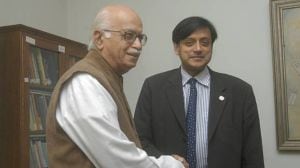The spirituality supermarket
Just as some human beings are compelled to explore the physical world as scientists, geographers or naturalists, others are compelled to e...

Just as some human beings are compelled to explore the physical world as scientists, geographers or naturalists, others are compelled to explore the states of consciousness. For many such explorers, drugs have been a common vehicle. In the early Seventies when the psychedelic revolution was raging through the world, millions of seekers opened up their synapses through the use of LSD and experienced an altered state of consciousness which was stunningly different from their mundane lives. But, as with all highs,’ this chemically-induced audio-visual explosion faded and each trip’ ended in darkness, leaving the experience’ hungering for light. And so he turned for help to Gurus who promised to make the light’ last forever.
In my own search for permanent light, having experimented with LSD, at 25 I entered into the spiritual sanctuary of Bhagwan Shree Rajneesh. Here, I discovered that his disciples lived out their religious fantasies as if they were really happening to them. In a collective hallucination, they were kept narcotised with regular doses of Rajneesh’s spiritual discourses and meditation lessons. But like drugs, even this euphoria began to fade. After devoting two and half years of my life to meditation and reading countless books of his philosophy, I was left hungering for the amazing sensations I had once experienced on LSD. I had gotten nowhere close to that. So I left his make-believe world, opting to live in the real one like millions do. I left with nothing to hold onto except a garbage sack of spiritual jargon and useless meditative techniques. Six years later when I met Rajneesh in Mumbai, I confronted him with some hard questions.
“Do you have anything apart from words to offer to your sanyasis who come looking to you for enlightenment?”, I asked Rajneesh who, even after he was thrown out of America, retained his arrogance. “I as a film-maker realise that I’m in business because people are lonely,” I continued, “Don’t you think you’re in business because people are miserable? Even J. Krishnamurthy towards the end of his life had confessed that he too had become a part of the entertainment industry…
“What is wrong with entertainment?” he shouted, waving his manicured hand and seething with anger. “People are unhappy. Why should one not relieve them of their woes for a while by entertaining them? What’s wrong with entertainment? What?” He was called away for his evening discourse before he could say more. He walked away looking like a tired actor, long past his peak, dragging himself to do his next shot. Neither of us realised then that in his spontaneous retort he had unwittingly confessed to me what the Holy business’ was all about – entertainment! That’s what it is all about! Like movies, theme parks, political speeches, designer drugs and endless other entertainment products, holy men offer us a life of fantasy; full of instant paradises, painless solutions, and permanent pleasure. Rajneesh was offering his disciples what every entertainer offers his consumers; a fictionalised realisation of humanity’s dearest dream: Transcendence.
While movies depend on technology to transport us to another land, the religious establishment uses the dazzle of the godman’s words to mesmerise his disciples into a joyous stupor. This longing of man expresses his need for an idealised existence not stained with evil and imperfection. Unfortunately, this quest also makes us regress into a state of unhealthy happiness, with simplified visions of life, filtering out the difficult truths of reality. Movies and gurus offer us happy endings; the only difference is that movies give us a sensory experience in the here and now, with no promises after the curtain comes down, while the holy man tells his disciples that months, even years later, they are sure to achieve Nirvana. At worst it won’t be in this life but in the next one! The holy business is simply an integral part of the multi-billion dollar Feel Good’ industry.
In this supermarket, for a buyer looking for a spiritual fix everything is available. It’s like a street with hundreds of shops. There’s Rajneesh’s sex shop next to J. Krishnamurthi’s awareness shop, which is next to Maharishi’s meditation shop, which is next to Sai Baba’s magic shop. Rajneesh was an astounding success at selling his wares, his ship starting out from a small, seven-acre ashram in Pune, expanding to an empire with 750 meditation centers across 80 countries in the world. The Osho commune has vaults of tape-recordings of his discourses, books in several languages, paintings, Rolls Royce cars, diamond robes and countless accessories worth a fortune.
A spiritual haven which has become such a gold mine is bound to have people fighting for their share of the pie. Which is exactly what started happening in his appointed Inner Circle after his death. A huge power struggle has erupted in his commune over the proprietorship of his legacy. And despite the torrid pleas of the Indian Oshoites opposing the demand of the Osho International Foundation to place copyright laws on all of Rajneesh’s works, despite Ma Yoga Neelam saying that Rajneesh never intended to make money and that there can never be a copyright on his thoughts, it has become clear that in the Osho Commune, spiritualism òf40óis materialism and it has never been anything but that. Dividing life into the material and the spiritual is responsible for the mess that Indian’ Oshoites find themselves in. The spirituality that Oshoites claim to teach to the world has actually never operated in their own lives and never operated in Rajneesh’s own life. Yes, he was a gifted man with special insightsinto human desire and longing, who used words and concepts to inspire lost people. Like politicians use rhetoric and thrive on the gullibility of men, religious people like Rajneesh thrive on the credulity of miserable people and fool them. He was a wordsmith par excellence who has left a huge body of work which is today in great demand in this age of entertainment.
In a book called òf40óThe God That Failed, a disciple writes that once when Rajneesh was rambling after having inhaled nitrous oxide, he said, “I am so relieved that I don’t have to pretend to be enlightened anymore. Poor Krishnamurthy, he still has to pretend.” Rajneesh was too intelligent to fall victim to the illusions he manufactured for his sanyasis. That is why he was a great success. His quarrelling followers should recognise that the future of the Osho Commune lies in the unpretentious and aggressive marketing of their guru’s spiritual products. They would be foolish not to see the obvious: the only reality is the market.



- 01
- 02
- 03
- 04
- 05




























